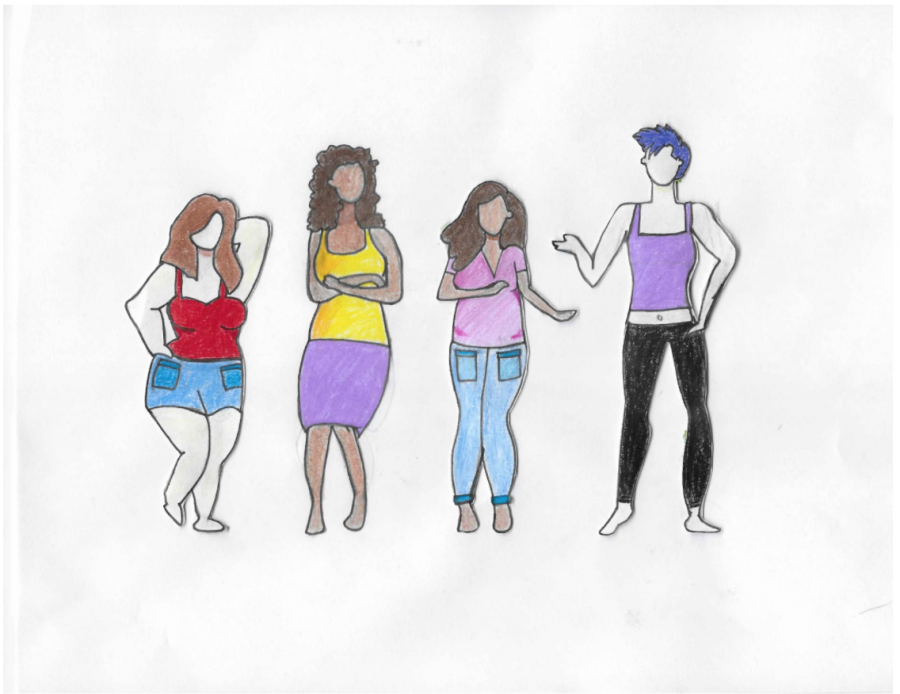Size blind
Social media body positivity during and after quarantine
“Work out with me! Just 10 minutes of abs a day to get your perfect summer body!” says a perky, thin girl as she jumps across my phone screen. As girls scroll through their social media feeds, they are constantly bombarded with methods, often unhealthy, to attain the “best” body. However, no girl should feel that she has to alter her body to make it worthy of a bikini or acceptance.
All over popular social media platforms such as TikTok and Instagram, influencers and regular users alike are posting ways that they are staying busy during COVID-19 self-isolation. These people also tend to be divided into groups of those who have decided to work out constantly to “get skinny and glow up” during the unforeseen break, and those who have resigned themselves to bad sleep schedules, baking, eating junk food and what they deem “being fat”. These extremes are posted side by side all over social media, and it’s enough to confuse even the most secure individual. What’s more, nearly every one of these posts are by teenage girls.
So, girls in quarantine face a double dilemma: some of the only ideas they are getting to keep themselves busy during this time are too heavily polarized to be healthy for their bodies, and the concepts of “fat” versus “skinny” behind them are perpetuating the mental cycle of body-shaming and eating disorders that have tailed them for centuries.
Girls scrolling through TikTok are quickly trained to believe that if they touch a sweet, their bodies will not be good enough for the girls who are working out, and they may end up undereating and harming themselves. On the other hand, some girls may see someone eating a lot of junk food on their page, and that may promote overeating, which is also harmful to the body. The key to sustainable health and weight is a balance of food and exercise, but this is simply not what is being advertised on social media platforms, especially during, but also beyond this period of self-isolation.
The more concerning and far reaching effects, however, are the mental implications of these contrasting posts. As girls remain inside with less school work and no sports or their usual physical activity, they have more time to focus on social media just as it scorns them for the natural weight gain associated with being more sedentary. This period has only magnified the struggle of girls to live up to society and social media’s expectations of their bodies, with many boys posting reaction videos ogling only thin girls.
“What I eat in a day” videos, which were already plentiful before quarantine, have become unavoidable during. All too often, slim girls will present a few apple slices with a dollop of peanut butter and a protein bar as their meals for the day. While this may be a healthy and viable option for certain girls under certain circumstances, it is important not to normalize it as a common eating habit.
In the comments sections of these videos, girls bemoan that they do not have such a “perfect” body. Others see this praise and desire it, leading to under and overeating and, in extreme cases, eating disorders.
Disorders such as anorexia nervosa and bulimia nervosa have increased exponentially each year since 2012 when social media began to pick up with teenagers. Still, videos promoting unhealthy eating or exercise habits with comments such as “I guess I’m not eating today.” remain unblocked on many social media sites. In fact, they are positively encouraged, as they often show up as recommended. Then, on these same platforms, society falsely claims to be entering a body-positive age where size does not determine beauty or worth.
How can teenage girls preach body positivity when the vast majority of us continue to relentlessly pursue the acquisition of the “ideal” thin female body? The only way that we can be happy and healthy, especially on social media, is to destroy the link between size and worth as a human being. Girls are born with all different body types, and it is ridiculous for them to place their worth in all looking exactly the same.
And, although these trends are largely female-focused, there are also many that target those who identify as male. TikTok “push-up and pull-up challenges” pit boys against one another in harmful strength challenges that perpetuate ideals of toxic masculinity. Boys are ridiculed in videos and comments for not being “strong enough”, as though high physical capacity is an accurate measure of any male’s worth. Then, only in the comments sections of videos posted by “strong” boys, girls ask if they “want a girlfriend”, feeding the unhealthy idea that boys are only wanted if they are muscular and traditionally masculine.
Thankfully we, as teenagers, are in a unique position to solve our own problem.
Starting during self-isolation, when we have even more time to be reflective and less stressed and competitive, girls need to stop posting about food and workouts. If a friend wants an example of a diet and exercise to help them become more balanced and healthy, then send it to them privately. We Jones students are trained to be competitive, from ACT scores to grades, but, in the absence of online body competition, everyone will find themselves more comfortable in their own skins.
Teenagers should also have a social media cleanse if they feel overwhelmed. Taking a break from internet negativity to focus on ourselves and spend time with our families is important. Positivity can’t happen all at once, so pressing pause may be necessary.
Teenagers should feel free to eat until they feel full and exercise until they feel strong without fear of judgment. This nurtures our bodies and improves our brain function, where our personalities and intelligence, the parts of us that really count, come from.
Just as teenagers of every gender must support those that identify the same way as we do, we must also bolster other genders. We should try not to comment on our peers’ bodies or appearance too often because it is a small part of who we all are. Enjoy each other’s presence and thoughts, not just looks.
Teenagers must begin to shatter the notion of the idealized body type during this period of body uncertainty and competition so that our bodies and minds can thrive.





